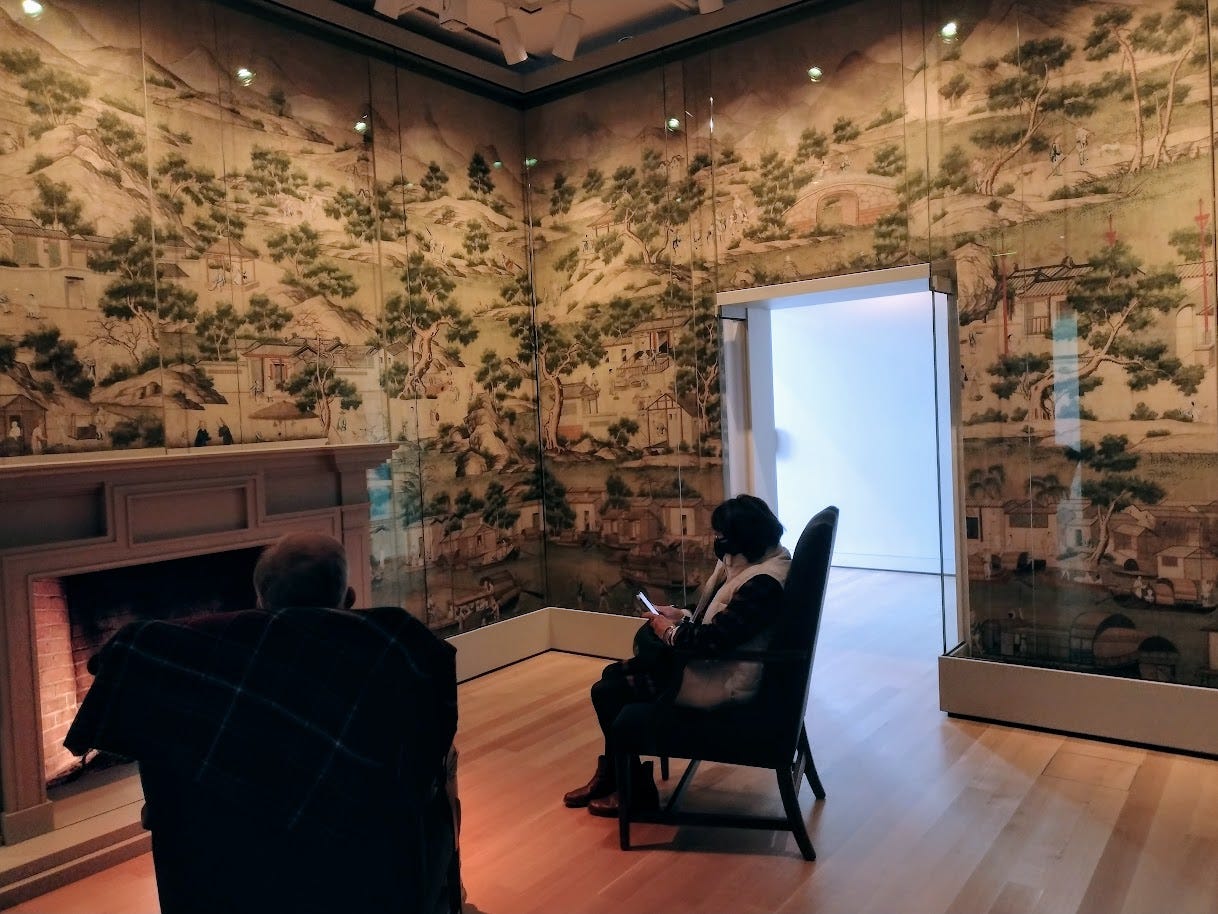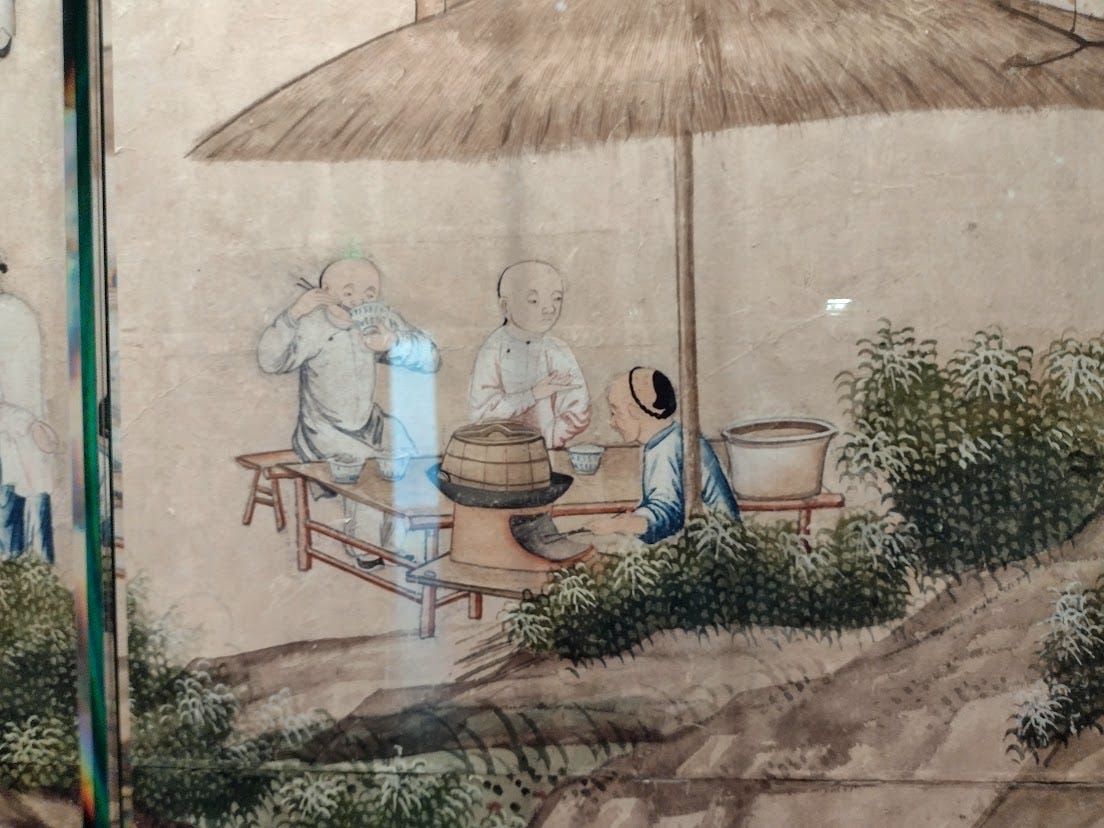Cool Chinese Imports
ANNETTE ON THE ROAD Surprises in Salem (2) Two Exhibits at Peabody Essex Museum

If you’re a sometime reader of Non-Boring History, I just got home from New England, where I was perusing history-related stuff, mostly in the area of Salem, Massachusetts, with my tolerant spouse, He Who Shall Not Be Named On the Internets (HWSNBNOTI, pronounced Hoosen Benoti). I’m finishing up posts about my discoveries on the road.
Confused? Please review the orientation post. Hope that helps!
NEWSFLASH 🎉🎉🎉
Hope you enjoyed my last post, Dick Van Dyke and a Country Church.
So did Dick Van Dyke.

I'll give you a moment to imagine the celebrations at Non-Boring House. Oh, and please know I gave the Social Media Gnomes a raise.
Unexpected Architecture
Thinking about moving? Here’s a house for your consideration: Sixteen bedrooms, two reception rooms, a storage area, all on two stories (storeys if you’re in the UK), built around a central open courtyard.
And it's off the grid! Two courtyard pools collect rainwater. You have no electricity, but plenty of firewood. The house has no outside windows, but all rooms open into the open courtyard for fresh air and light, just like 97 year old billionaire Charlie Munger's recent proposal for a student residence at UC Santa Barbara.
Did I mention you will share this house with three generations of your in-laws?
But wait, there's more!
Yin Yu Tang (Hall of Plentiful Shelter) was home to a businessman named Huang and his descendants for nearly two hundred years, until the family abandoned it in the 1980s.
And now it's in Massachusetts.
That's right, all the way from China.
Why am I suddenly thinking of that Danish windmill rebuilt as a tourist attraction in Iowa? Or old London Bridge, now resident in the desert town of Lake Havasu, Arizona, with a registered trademark symbol attached to its name, as in The London Bridge ®?
While the British, um, acquired their imported museum pieces, Americans are fond of buying entire historical structures fair and square.
So yes, Peabody Essex Museum (PEM) purchased the Yin Yu Tang house, kit and kaboodle, then had it dismantled, and moved it to Salem, home of much historical trade with China, as I'll talk about later in this post.
Here, it was erected in a dedicated space on the museum’s fancy new campus. It's the only actual Chinese (as opposed to Chinese-American) architecture in the US. And while it was sitting around unloved in China, it now offers a fascinating window into Chinese culture for Americans, starting with that thing about living with your parents or in-laws, a custom that’s being swept away by modern life in China.

Hoosen and I thoroughly enjoyed exploring this place. In design, it reminded me a little of a galleried coaching inn that you would have found in London at the same time, like the Tabard Inn mentioned in Chaucer’s Canterbury Tales, which burned in 1669. Sadly, only one remains, the George Inn (burned 1676, rebuilt, because everything in London gets burned/knocked down eventually) In other words, it looks like a motel. But this is likely a coincidence in the case of Yin Yu Tang.
In the Yin Yu Tang house, among the later residents were a young couple who lived in this upstairs room in the Sixties (the Mao jacket is your hint). I'm standing in the doorway taking the photo, so my back is to the courtyard.
In the first hundred years or so of Yin Yu Tang’s existence, the family’s men, who were merchants, traveled to work hundreds of miles away, leaving the women and children to live in the house. Families might not see their menfolk for two years at a stretch.
“How did they have all those kids, then?” I said to Hoosen. We agreed it was a mystery.
The women of the large extended family often sat in the open-air courtyard (the only well-lit place in the house) to sew, prepare vegetables, and chat. They also worked in kitchens that were separate from the house, for fire prevention.
When a young woman married and moved in with her in-laws, she celebrated the first full day of her honeymoon by getting up early and cooking breakfast for her new husband and his entire family, including her mother-in-law. That must have been fun. No pressure there.
I must say, the Yin Yu Tang kitchen looked surprisingly familiar.

Great! An Excuse to Talk Chinese Food!
Hoosen is Asian-American from California, and so will patronize any crappy cheap Chinese hole in the wall, no nonsense about “authenticity”. I suggested he ask to be paid to pose with his carry-out bag outside our local Chinese joint in Atlanta (where everyone else who ate was an old white Southern person) to make the place seem more authentic.
But I'm the cook at home, and I enjoy making proper Chinese-American food. It's not what you likely get in China, please note. Nor is it the deep-fried meats in syrup sauce you might get at your local takeaway.
It is its own thing, the tasty, healthy, homemade Chinese-American food of California, as explained in Californian Grace Young's awesome cookbooks, like Stir-Frying to the Sky's Edge, and The Breath of the Wok.
A few simple techniques, and you too will throw away all those Chinese takeaway menus you have stuck to your fridge! Never again worry about what to do with those little packets of soy sauce!
I’ve got a real wok, myself, as you do when you're serious about showing off. I ordered it on the interwebs from The Wok Shop in San Francisco (as ever, NO paid placements or kickbacks, guys.) You will be gobsmacked by their cheap prices! Buy a bamboo scrubber and other accessories while you’re there! No, still not being paid to promote them.
One day, I have to chat with you about the whole “Asian in California” thing, speaking as one of two white Brits married into the same pan-Asian-American California family. Meanwhile, here's talented California cookbook author Grace Young to explain (hilariously) why proper woks are not scary, but living cool thingies:
Okay, where was I? The Yin Yu Tang House Kitchen!
Behold! Two woks on just two burners, as is still the case in a modern Chinese apartment, bamboo scrubber to clean the woks (still a thing), nifty spatula, and cool baskety ladle thing that’s much easier to wrangle than a slotted spoon. Behind us is the chopping block with veg ready to go. Honestly, it looked far less alien than the many massive Victorian country kitchens I've traipsed around in England. Everyday Chinese food is really not hard. I could seriously have got a fire started and got to work in here. Velveted chicken and asparagus, anyone?
Mind you, I would miss my oven. None in a traditional Chinese kitchen.

Meals at Yin Yu Tang were taken in a very casual way we will recognize: You grabbed your plate from the kitchen, and took it to wherever you wanted to eat, a cosy spot in the house, perhaps, or into the village to dine with your friends.
That’s one way you got away from the in-laws.
Virtually Visiting
If you plan to visit the Yin Yu Tang House, it’s included in admission (a steep $20 for adults) to the Peabody Essex Museum in Salem, Massachusetts, as is the free audioguide. You should arrive early, especially in busy season, and go collect timed tickets from the information desk to avoid disappointment.
Not likely to be in Salem anytime soon? The museum offers a very nifty virtual tour. Click on the little bubbles to learn about each part of the House. If you have a hard time getting “inside”, just click to the LEFT of the wooden screen.
And if you do go to Salem? Express your outrage about the lack of a permanent exhibit on the witchcraft episode of 1692.
When Chinese Imports* Were All the Rage
*bought with drugs
Imagine having a virtual reality room where you could visit a city you loved!
Have a look at this. It’s just one detail from the complete bespoke (custom-made) wallpaper of James Drummond (1767-1851), in Strathallan Castle in Auchterarder, Perthshire, in the Highlands of Scotland.
How did Chinese wallpaper end up on the walls of a Scottish castle around 1800?





